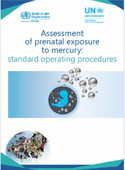Assessment of prenatal exposure to mercury: standard operating procedures (2018)

Download
Mercury is toxic for humans, and the toxic effects of different forms of mercury have been extensively studied. Human biomonitoring is recognized as the most effective tool for evaluation of cumulative human exposure to mercury. In-utero development is the most vulnerable stage for the long-term adverse neurodevelopmental effects of mercury. Characterizing prenatal exposure is critical for evaluating public health impacts of mercury and assessing public health benefits of exposure reduction measures. Approaches to estimating exposure to mercury include measuring mercury levels in different biological matrices. The level of mercury in tissues can be an indicator of exposure to various types of mercury. The validity, usefulness and meaning of such measurements depend on the form of mercury exposure, type of tissue measurement and other factors. This document consists of standard operating procedures describing the assessment of mercury in hair, cord blood and urine. Quality control is essential to get reliable results. The document also provides information on alternative methods that can be used for analysis of mercury.



